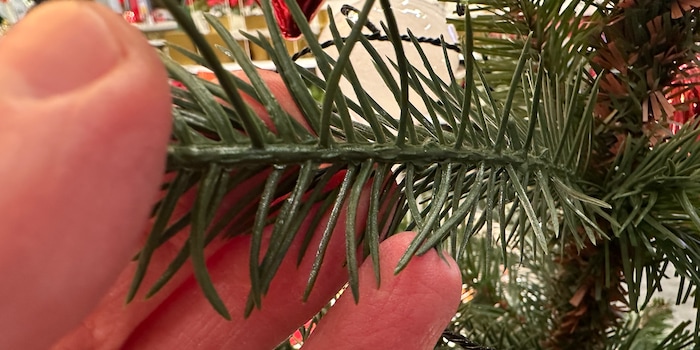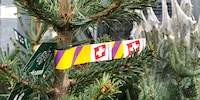

Real vs. fake: which Christmas tree is more sustainable?
Chopping down young fir trees doesn’t sound particularly eco-friendly. And yet, plastic alternatives are only better for the planet if very specific conditions are met.
In Switzerland, Germany and Austria, around 30 million real Christmas trees are likely to be bought again this year. People are out scouting for that perfect Xmas tree in front of supermarkets, in DIY stores or at farmers’ markets. Ideally, one that’ll fit in the car.
But couldn’t we just all save ourselves the hassle and maybe even do the planet a favour by going for a fake one?
Let’s cut to the chase: to be more environmentally friendly than a real tree, you’d have to use a plastic one for 17 years. Several factors are to blame for this.
1. Plastic drives up emissions
Artificial trees are usually made of plastic, namely polyvinyl chloride (PVC) for most of them. For each kilogramme of petroleum-based plastic produced, the equivalent of around eight kilogrammes of CO₂ are emitted. Polyethelene (PE), another popular material used for the production of fake trees, emits six kilogrammes of CO₂ for each kilo of tree. This makes it slightly less harmful to the climate than PVC, but still worse than a real tree. British researchers have found that the production of a fake tree that’s around two metres tall generates the equivalent of 40 kilos of CO₂. Two thirds of this is for the material. Another third’s caused by energy-intensive factory production, where high temperatures are needed to melt and shape the plastic. Incidentally, the figures I’m quoting are from a study published in 2009 by the Canadian consulting company Ellipsos – if you feel like going down the rabbit hole.
If you’re curious to see how a fake tree’s produced, check out the video below (in German). It shows a relatively expensive tree produced in Poland.

2. Transportation increases the CO₂ footprint
Emissions don’t end at production. Ideally, a real Christmas tree was felled close to where you’re buying it. Assuming that the distance from the dealer to your home is five kilometres, you need to add just under two kilos of carbon dioxide if you drive a diesel- or petrol-powered car. Transporting a plastic tree will add another five kilos to the production costs. You can get these numbers by using an online CO₂ calculator for logistics. Artificial trees almost always come from China and will have travelled long distances on heavy oil-powered container ships. But that only happens once, whereas you’re driving around every year to get a real tree. But who knows, maybe trees will soon be delivered by drone or electrically powered robot.
3. Disposal difficult for both
Once the holidays are over, the artificial tree goes back into the cellar and is brought out again year after year. But the time will come when you’re going to have to get rid of it. In theory, PVC and PE are recyclable materials. However, only if they’re in their pure form. This is rarely the case with plastic fir trees. Just think of all the metal used to make the branches bendy, or even LED fairy lights that are permanently installed. Dealing with such a mix of materials often only leaves one option for disposal: incineration. This adds another three kilogrammes of CO₂ to the bill. In total, your average Christmas tree produces 48 kilos of climate-damaging gas during production, transportation and disposal.
By the way, that’s still less than a new iPhone that might just be under that tree. According to Apple’s own Environmental Progress Report, an iPhone 15 with 128 GB memory has a carbon footprint of 56 kilos.
A real tree from your local forest or a Nordmann fir from a Danish plantation emits around 15 kilos of CO₂ when it’s burned. Representatives of the forestry industry insist that these aren’t new emissions, as the tree would’ve already absorbed the same amount from the atmosphere when it was growing. So in their view, the emissions can’t be attributed to the tree. However, it’s also a fact that the areas used for growing Christmas trees could be used for deciduous forests, for example. These store much more CO₂ than fir trees and do so permanently, as they’re not being felled every winter.
The verdict: it’s complicated
If you’re buying your Xmas tree from the farmer up the road who gets it from a forest on the outskirts of the village and you’re carrying it home with pure muscle power, then a plastic alternative doesn’t stand a chance ecologically. If, however, you’re going for an uncertified Nordmann fir that’s been grown on a Polish plantation, treated with pesticides and transported to the point of sale by diesel truck, a multi-use fake tree will soon catch up in terms of eco-friendliness.
Ultimately, it depends on many factors whether an artificial Christmas tree pays off for the planet. Sustainability’s rarely black or white. If you want to get down to the nitty-gritty, I recommend using the Christmas tree calculator in Excel format (in German).
And while we’re at it, an average roast turkey creates 10.9 kilos or carbon emissions. With this in mind, it might be worth thinking about where you’re prepared to cut corners to reduce global warming.
It's Christmas tree time!
What kind of tree do you go for?
- Every year, I get my tree from trusted local dealer.24%
- I'm tree-free and loving it.18%
- I like a big selection and attractive prices, so I usually get mine from the supermarket or a DIY store.11%
- I have a fake tree I put up every year.39%
- I've got a potted tree I borrow every year.4%
- I axe-chop my tree I get from my very own forest.5%
The competition has ended.
Journalist since 1997. Stopovers in Franconia (or the Franken region), Lake Constance, Obwalden, Nidwalden and Zurich. Father since 2014. Expert in editorial organisation and motivation. Focus on sustainability, home office tools, beautiful things for the home, creative toys and sports equipment.
Interesting facts about products, behind-the-scenes looks at manufacturers and deep-dives on interesting people.
Show all

